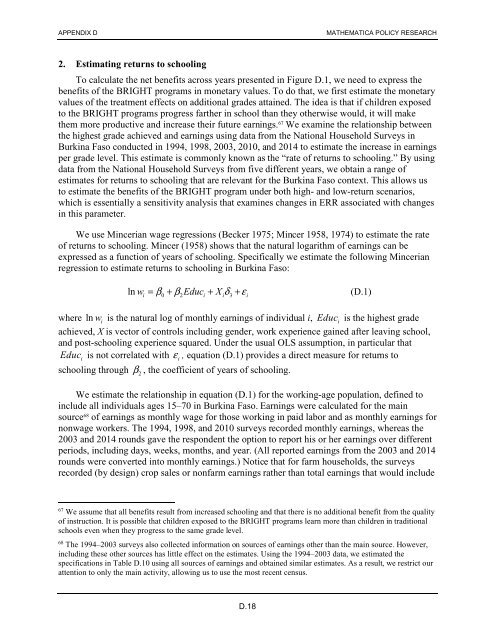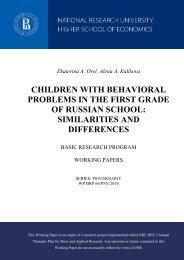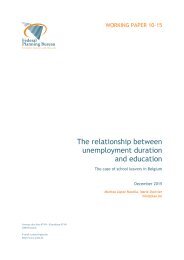Ten-Year Impacts of Burkina Faso’s BRIGHT Program
n?u=RePEc:mpr:mprres:2ecdd42bb503422b802ce20da2bf64b7&r=edu
n?u=RePEc:mpr:mprres:2ecdd42bb503422b802ce20da2bf64b7&r=edu
You also want an ePaper? Increase the reach of your titles
YUMPU automatically turns print PDFs into web optimized ePapers that Google loves.
APPENDIX D<br />
MATHEMATICA POLICY RESEARCH<br />
2. Estimating returns to schooling<br />
To calculate the net benefits across years presented in Figure D.1, we need to express the<br />
benefits <strong>of</strong> the <strong>BRIGHT</strong> programs in monetary values. To do that, we first estimate the monetary<br />
values <strong>of</strong> the treatment effects on additional grades attained. The idea is that if children exposed<br />
to the <strong>BRIGHT</strong> programs progress farther in school than they otherwise would, it will make<br />
them more productive and increase their future earnings. 67 We examine the relationship between<br />
the highest grade achieved and earnings using data from the National Household Surveys in<br />
<strong>Burkina</strong> Faso conducted in 1994, 1998, 2003, 2010, and 2014 to estimate the increase in earnings<br />
per grade level. This estimate is commonly known as the “rate <strong>of</strong> returns to schooling.” By using<br />
data from the National Household Surveys from five different years, we obtain a range <strong>of</strong><br />
estimates for returns to schooling that are relevant for the <strong>Burkina</strong> Faso context. This allows us<br />
to estimate the benefits <strong>of</strong> the <strong>BRIGHT</strong> program under both high- and low-return scenarios,<br />
which is essentially a sensitivity analysis that examines changes in ERR associated with changes<br />
in this parameter.<br />
We use Mincerian wage regressions (Becker 1975; Mincer 1958, 1974) to estimate the rate<br />
<strong>of</strong> returns to schooling. Mincer (1958) shows that the natural logarithm <strong>of</strong> earnings can be<br />
expressed as a function <strong>of</strong> years <strong>of</strong> schooling. Specifically we estimate the following Mincerian<br />
regression to estimate returns to schooling in <strong>Burkina</strong> Faso:<br />
= β + β + δ + ε<br />
(D.1)<br />
ln w i 0 2Educ i<br />
X i 3 i<br />
where ln w i<br />
is the natural log <strong>of</strong> monthly earnings <strong>of</strong> individual i, Educ<br />
i<br />
is the highest grade<br />
achieved, X is vector <strong>of</strong> controls including gender, work experience gained after leaving school,<br />
and post-schooling experience squared. Under the usual OLS assumption, in particular that<br />
Educ<br />
i<br />
is not correlated with ε<br />
i<br />
, equation (D.1) provides a direct measure for returns to<br />
schooling through β<br />
2<br />
, the coefficient <strong>of</strong> years <strong>of</strong> schooling.<br />
We estimate the relationship in equation (D.1) for the working-age population, defined to<br />
include all individuals ages 15–70 in <strong>Burkina</strong> Faso. Earnings were calculated for the main<br />
source 68 <strong>of</strong> earnings as monthly wage for those working in paid labor and as monthly earnings for<br />
nonwage workers. The 1994, 1998, and 2010 surveys recorded monthly earnings, whereas the<br />
2003 and 2014 rounds gave the respondent the option to report his or her earnings over different<br />
periods, including days, weeks, months, and year. (All reported earnings from the 2003 and 2014<br />
rounds were converted into monthly earnings.) Notice that for farm households, the surveys<br />
recorded (by design) crop sales or nonfarm earnings rather than total earnings that would include<br />
67<br />
We assume that all benefits result from increased schooling and that there is no additional benefit from the quality<br />
<strong>of</strong> instruction. It is possible that children exposed to the <strong>BRIGHT</strong> programs learn more than children in traditional<br />
schools even when they progress to the same grade level.<br />
68<br />
The 1994–2003 surveys also collected information on sources <strong>of</strong> earnings other than the main source. However,<br />
including these other sources has little effect on the estimates. Using the 1994–2003 data, we estimated the<br />
specifications in Table D.10 using all sources <strong>of</strong> earnings and obtained similar estimates. As a result, we restrict our<br />
attention to only the main activity, allowing us to use the most recent census.<br />
D.18







